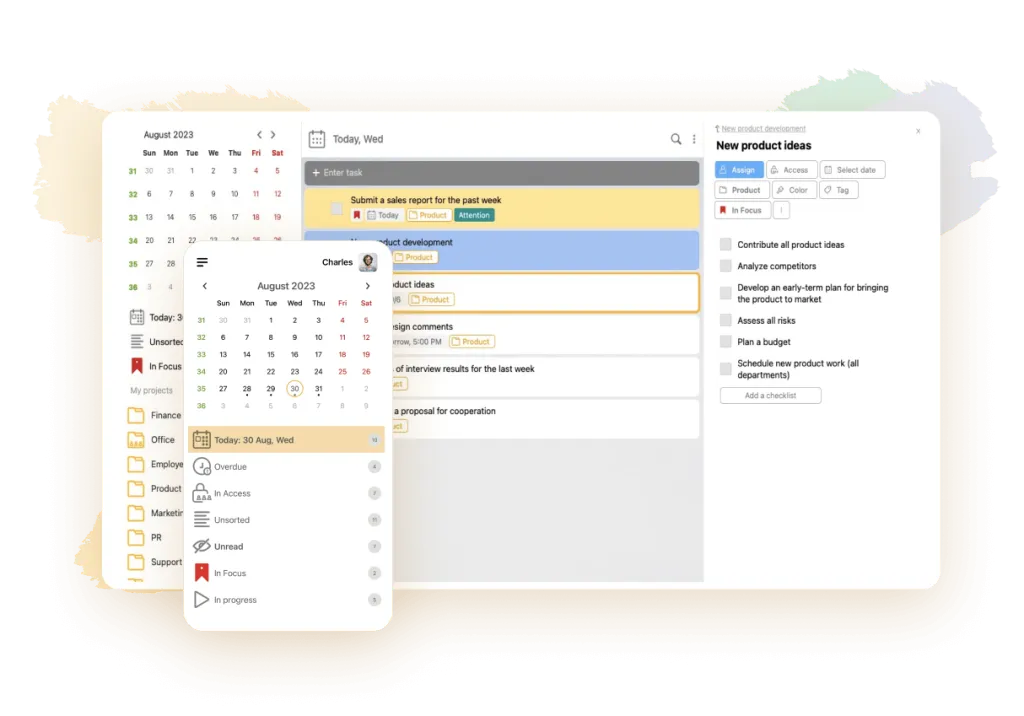
Ted Scott
February 7, 2024
It’s no secret that people who carefully plan ahead achieve great results in their personal lives and careers. But is it easy to master such a skill as planning and should everyone learn to use it? What principles and methods are recommended to know in order to achieve goals in a timely manner? Is it necessary to master all of them? Let’s understand the questions together.
What is planning as a process
Planning is a qualitative preparation for any activity. The concept implies setting goals and forming tasks with optimal allocation of material, time and psychological resources necessary to achieve the desired results. Advance planning organization and forecasting help to distribute forces more correctly and face less economic, production and other losses in the process of achieving goals.
In this case, short- and medium-term planning, regardless of the type of activity and human capabilities, is most often carried out according to a certain technology with the allocation of the following stages:
-
Analyzing the starting state.
-
Establishment and formulation of goals - a basic reference point on the way forward.
-
Creation of a development concept, selection of methods for project implementation.
-
Strategic and tactical planning - determining the ways and resources for the realization of the conceived, their ideal distribution.
-
Operational and calendar planning with step-by-step scheduling of future time-bound actions.
-
Approval of the plan, acceptance for execution.
An important feature of planning and organizing activities is the operational movement from the large-scale to the particular, from the general understanding of the mission to the small daily tasks of the day. At the same time, time control and serious attitude to one’s own schedule, strict adherence to the schedule is of fundamental importance. Only in this case strategic planning facilitates the performance of work, accelerates labor processes, leads to significant savings of time and resources, frees up additional periods of time in the day.
Why you need planning
The practical benefits of regular scheduling are undeniable. Making a schedule for the day allows a person to:
-
not to forget anything;
-
to do more in less time;
-
Use a proactive rather than reactive mode of action;
-
to make the best decisions possible;
-
to recover in a timely manner, to work after rest with the highest productivity.
Remember that a plan for the day is always a guarantee of a successful start or completion of any business, quality rest, the ability to do everything in time and complete the work on time. In addition, no major changes in life are impossible without a preliminary and effective planning of activities. A carefully planned schedule of the day helps to correctly calculate the forces, make strategically correct decisions.
Planning principles
Thorough and meticulous pre-planning and thinking things through beforehand becomes several times more productive and helps you achieve your goals in the shortest possible time if you follow a number of basic guidelines. Let’s include the main ones in the list:
-
Try to accomplish most of what you have planned in the first half of the day.
-
Create a realistic schedule, don’t overwhelm yourself with a huge amount of work.
-
Scale tasks in small parts.
-
Leave time in the day for rest, force majeure.
-
Do not try to do everything at once if there are too many to do. Select only important tasks by categorizing the task list into priority and urgent tasks.
-
At the end of each day, compile the content of the work schedule for the next day. Also at the end of the week, write down the schedule for the coming week in the same way.
-
Don’t rely on memory, take notes. Carry a notebook with a pen or voice recorder to capture interesting thoughts as they arise or to edit previously added notes.
-
Start a success diary and regularly note your own achievements.
-
Try different planning methods and choose the most appropriate ones.
-
Concentrate on what’s important, don’t waste time.
-
Know how to say “no” to unnecessary meetings, advice, events, suggestions, communication. Not to do other people’s business, not to perform unnecessary actions.
-
Avoid rash actions and behaviors, always weigh your own decisions before you do anything. Get rid of unproductive habits and characteristics that take up time and do not allow you to move towards your goals.
-
Determine your life priorities, live in accordance with them.
-
Regularly allocate time for self-development and self-improvement (reading, sports, various trainings).
-
Do not stop at what has been achieved, keep yourself energized. After accomplishing a goal, immediately set the next one.
Daily use of these skills, their regular application in practice should be a part of life. In this case, the process of planning your activities will make you more efficient, more organized, more successful.

Main planning methods
Let’s look at the most popular planning methods. There is no need to try to implement all of them at once. Try to bring each technique to life one by one, then select among them the most useful and convenient for use in the company or for personal purposes.
1. SMART
One of the most popular planning techniques in the world, it is successfully used to define goals and set a variety of objectives. It is perfect for organizing work issues, production, business planning and for personal development of a person.
The essence of the methodology:
Named after an abbreviation of the words, deciphered as follows: S - specific, M - measurable, A - assignable, R - realistic, T - time related.
Thus, all goals that a person sets for himself must:
-
be clearly articulated and specific;
-
have measurability and attainability;
-
correlate with other tasks;
-
have a clearly defined time frame for execution.
These factors allow you not only to make the right plan, but also to determine the necessary actions to achieve the desired result, to take into account all possible factors, to be able to monitor your own progress.
2. ABC
A simple technique that allows you to categorize tasks according to their importance. It is based on the famous Pareto principle, the essence of which states that 20% of all activities produce 80% of the results, while the remaining 80% of activities produce 20% of the results.
The essence of the methodology:
Planning involves dividing current affairs into three categories, among which are:
-
Category A - the most important assignments (15%), which require priority resolution and yield up to 65% of results;
-
Category B - important tasks (20%), are also useful to accomplish and produce about 20% of the results;
-
Category C - tasks of low importance (65%), yielding no more than 15% of results.
When planning your workday according to this system, you should pay attention to the tasks in the first category. In most cases, they require less effort and output than the cases in category C, but they are more useful and need to be solved as soon as possible.
3. GTD (Getting Things Done)
David Allen, an American time management expert and personal productivity consultant, was the first to talk about it. The technique is excellent for keeping a desk diary and allows you to concentrate on the realization of tasks.
The essence of the methodology:
Planning involves writing down one’s goals in a business diary. In this case, each business begins with the designation of special symbols:
-
empty circle - task to be performed;
-
crossed-out circle - the currently running task;
-
a half-painted circle - incomplete task;
-
a shaded circle - completed task;
-
circle with a cross in it - canceled task;
-
shaded circle with an arrow - delegated task;
-
exclamation point - priority problem;
-
circle with a dot in it - task that must be kept in mind at all times.
This metric-tracking methodology is great for immediate business planning, but not so great for long-term planning. Therefore, GTD is best used as a supplement to prioritize existing goals in your business or personal life.
4. Method 1 - 3 - 5
A universal technology, very popular among adepts of personal productivity. It has various forms and variations. Fits into the life of any person and organization, suitable for making plans for a day, week, month, year and more.
The essence of the methodology:
It provides for daily allocation of nine tasks from the full list. It requires mandatory ranking: 1 task is the key task, which has a global priority; 3 tasks - things to be solved during the working day; 5 - small tasks to be performed as far as possible.
The number of cases should not exceed nine, otherwise the method is considered ineffective and unworkable. This rule is difficult to adhere to on those days when the list of necessary tasks grows a lot. However, the advantage of this technique is that activity planning eliminates most of the unnecessary tasks by itself, and only the important ones automatically remain on the list.
5. Eisenhower’s Matrix
The founder of this popular method of time management was an American general, the 34th president of the United States, Dwight David Eisenhower, in honor of whom the method was named in this way. Being a busy man, he optimized his own work schedule with the help of a sequence of a special matrix.
Its meaning is to learn how to distribute tasks competently during the day, to distinguish important and urgent tasks in a succession of many non-urgent and unimportant tasks. It is suitable for management and subordinates, for personal and professional plans.
The essence of the methodology:
Management technology involves dividing cases into four quantitative categories, among which are:
-
A - important and urgent assignments;
-
B - important and non-urgent tasks;
-
C - unimportant and urgent matters;
-
D - unimportant and non-urgent tasks.
The first category should be done at a fast pace as soon as any errands appear in it. If they become too many, it signals disorganization, wrong prioritization and laziness.
It is advisable to pay the most attention to the category of medium-term affairs, as they are often the highest priority and most promising. An individual’s career and personal success depend on them. However, they are the ones that people put off more often than others and forget to plan. These include sports training, foreign language classes, professional development, various courses, all options for self-development.
Category C tasks should be delegated in order to achieve greater results in life (e.g. fixing the microwave, changing a light bulb). Category D tasks should be avoided because they are not useful and only take up time. These often include talking on the phone, browsing social networks, playing computer games, etc.
LeaderTask - successful team and strategic planning

Paper-based media are still used by the vast majority of people as planners. Only a few connoisseurs of time management prefer to use special software to set tasks and plan things. But the electronic approach greatly simplifies the setting of tasks and ensures their further fulfillment personally and in the company.
LeaderTask service consists of a whole set of tools, functions and means for individual and team planning and organization of activities using a computer or cell phone. The application is suitable for work in any direction: in sales, construction, tourism, beauty sphere, scientific and educational activities.
Using the program in online or offline mode, you can create entries for scheduled tasks and subtasks, notes, various files, checklists. Change the order of things, delete achieved goals, adjust conditions or change dates. And also keep a database of lists, documents, contacts, projects in different categories, themes, colors.
The built-in agenda allows you to track your schedule on a timeline, set the hours of the working day, make a plan for the day, week, month or any selected future date. Projects can be visualized on kanban boards. Pop-up notifications and reminders help you not to forget about appointments and dates, unfulfilled tasks.
Commit to planning your workday to become more productive in your career and personal life. Choose a suggested method. Write down goals, be clear and concise. Use LeaderTask’s online service for commitments and reminders. Never put off for tomorrow what can be done today.








